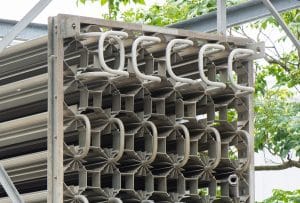 While different industries often share similar thermal management concerns, their specific needs can vary greatly. However, they all share the need for effective, efficient solutions that can perform consistently at minimal costs. Heat exchangers, such as heat pipe assemblies, are often utilized to meet those needs, and have become one of the most popular ways for dealing with electrical waste heat. For example, heat pipes that can be assembled to match any desired plane and angle can also be fashioned to meet almost any application’s performance parameters.
While different industries often share similar thermal management concerns, their specific needs can vary greatly. However, they all share the need for effective, efficient solutions that can perform consistently at minimal costs. Heat exchangers, such as heat pipe assemblies, are often utilized to meet those needs, and have become one of the most popular ways for dealing with electrical waste heat. For example, heat pipes that can be assembled to match any desired plane and angle can also be fashioned to meet almost any application’s performance parameters.
How heat pipe assemblies work
Heat pipes come in all shapes and sizes, but in each case, their goal is to rapidly transfer large amounts of electrical waste heat in the most efficient manner. This often includes natural heat transfer methods, such as phase-change cooling, that can prevent heat from accumulating so that sensitive electrical components are safe from overheating. Because thermal management needs can differ greatly from one application to the next, the fact that heat exchangers can be designed to meet each one’s specific needs makes them especially beneficial on an industrial level.
Benefiting from better thermal solutions
One of the most important reasons why heat pipes and other heat exchangers have remained so popular is because of the significant ways in which they transform electrical cooling and thermal management for most common applications. For example, by transferring heat within a heat pipe assembly instead of using air conditioning to blast heat with chilled air, companies can save significant amounts of money on energy costs, space on electrical cooling equipment, and time on system maintenance or repair. They also help companies improve productivity by streamlining operations and reducing interruptions and downtime.
Creating the right heat pipe assembly
Because every application comes with its own unique parameters, designing heat pipe assemblies for any given one often requires a high level of customization. The pipes should bend, flatten, and/or curve according to the space allotted to it within the application. They should also offer optimal cooling results in accordance with the application’s maximum operating temperature and intensity of waste heat generation. Their ability to be customized to meet any application’s needs is one of the biggest reasons why heat pipe assemblies are among the most common types of heat exchangers.
For more information about using heat pipes for custom thermal management, call Noren Thermal Solutions in Taylor, TX, at 866-936-6736.







